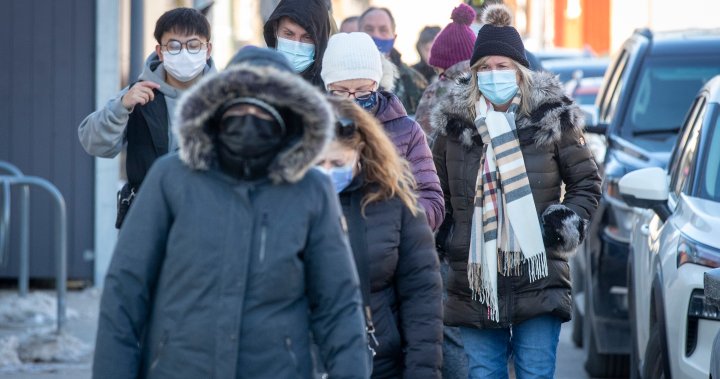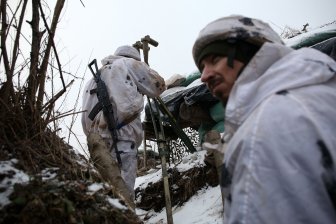Some provinces are loosening COVID-19 restrictions. Here’s why – National | Globalnews.ca
Canada’s top doctors said Friday that the Omicron wave of COVID-19 may have peaked in Canada and some provinces in the country are already moving ahead with easing restrictions based on key metrics, like hospitalizations and ICU admissions that are driving reopening plans.
Earlier this week, public health officials in Ontario said they have noted improving trends in the Omicron wave, which led the provincial government to announce loosening of some COVID-19 restrictions on certain businesses — including restaurants and gyms — starting from the end of January.
In a COVID-19 update Wednesday, Health Minister Christine Elliott said the province of Ontario was starting to see “glimmers of hope” in its fight against the Omicron variant.
Read more:
Canada’s Omicron wave of COVID-19 may have peaked, top doctors say
Dr. Kieran Moore, Ontario’s chief medical officer of health, said during the same update that the rate of hospitalizations and cases in the intensive care unit were increasing but at a much slower pace.
As of Friday, Ontario reported 4,114 people in hospital with COVID on Friday with 590 in intensive care units. Last Friday, hospitalizations were at 3,814, with the number of people in ICUs at 527.
In an email to Global News Thursday, a spokesperson for the Ontario government said that the province looked closely at hospitalizations and ICU admissions as some of the key metrics when deciding to move ahead with the easing of restrictions.
“We knew many healthcare workers are absent due to themselves getting COVID-19…but we’re starting to see that number stabilize and we’re able to provide care despite 100 per cent occupancy in some of our settings,” the email said, quoting Dr. Moore.

Other metrics under consideration included the number of people getting tested for COVID-19 and the number of outbreaks, particularly in long-term care sectors.
Like Ontario, the province of British Columbia, too, announced the easing of some COVID restrictions earlier this week. Based on modelling data released on Jan. 14, the province has taken the step to reopen gyms and exercise facilities with capacity limits and the continued use of the B.C. vaccine card as of Jan. 20, said B.C.’s top health officer Dr. Bonnie Henry.
The number of cases as well as the positivity rate appear to be set to decline in B.C, the data showed.
However, the number of people being admitted to hospital with COVID is expected to increase.
“Our modelling shows between Jan. 15 and 22, we expect the peak of admission in hospital,” Henry said last week.
British Columbia reported 15 more COVID-19-related deaths on Thursday, as it saw the number of cases in hospital dip for the first time in more than two weeks.
A spokesperson for British Columbia has also stated in an email that the metrics they use in decision making are the number of cases, immunizations rates, hospitalizations, outbreaks and clusters.
Are such metrics enough to ease restrictions?
A University of Toronto professor at the faculty of pharmacy, Zubin Austin, argued that a lot of these decisions focus only on one part of the health-care system — and that’s mainly ICUs within hospitals — and not enough on other sectors within the system.
“We need to worry about the entire health care system that includes things like long-term care institutions, primary care, and family doctor’s offices,’ said Austin.
“There’s so many other parts [of the system] that are extraordinarily overwhelmed. So as we base our decisions around reopening, we need to be mindful of these sectors as well,” he added.
Read more:
Unvaccinated patients and staffing shortages — A look inside the ICU at one Toronto hospital
Austin spoke with Global News from Fort Erie, a small town in Ontario, and he said the town’s only urgent care centre has closed because of staffing shortages and redeployment of health-care staff into hospitals.
“I don’t think you should be reopening the economy until there are enough health care workers to reopen my urgent care center here…and until urgent care can reopen in other small communities, I think we should be much more cautious than we’re being in terms of reopening the economy generally,” Austin said.

Similarly, Dr. Peter Juni of the Ontario COVID-19 Science Advisory Table said it’s not only the sectors of the health-care system that are struggling but all sectors of the economy and it’s not sufficient to base reopening decisions on just declining hospitalizations and ICU numbers.
“We need to hold on…we just need to keep controlling this wave as good as we can and just be a bit pragmatic right now. Nothing will be ideal, but that’s just the nature of the Omicron wave,” said Juni.
Juni also outlined that there’s a lack of data to support Ontario’s decision to ease restrictions. Hospitals remain jammed and schools have only recently gone back to in-person learning, he said.
He explained that even though Ontario expects to reach a plateau in terms of hospital and ICU occupancy, there still has been no decrease in the number of hospitalizations.
Read more:
As Omicron fuels COVID fatigue, Canadians weigh the risks for themselves
“We will need to wait now until next week…to see the number of people in the ICU and if there’s a slight downward trend. This will be important,” said Juni.
Austin also said that he is concerned about what the opening of schools is going to do in terms of transmission numbers.

Educators and students returned to Ontario classrooms this week, while B.C. students and staff returned to in-person learning with enhanced safety measures in place earlier in January.
“We’ll probably see a slight increase in infection rates now that schools are open. But I optimistically think that we won’t necessarily see that translating into ICU admissions,” said Austin.
“But we are going to see it translating into more demand on primary and urgent care,” he added.
— with files from Amy Judd, Richard Zussman, Ryan Rocca, Hannah Jackson.
© 2022 Global News, a division of Corus Entertainment Inc.
For all the latest health News Click Here




